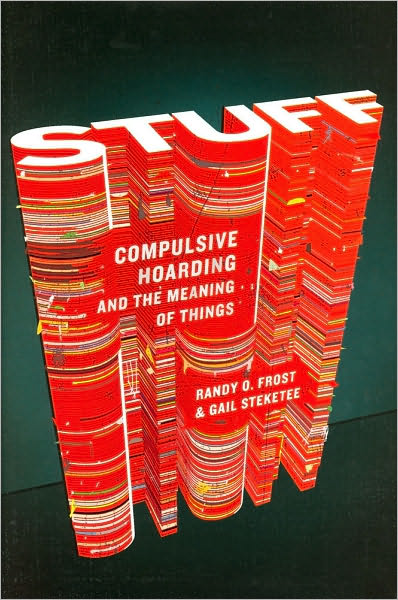Stuff: Compulsive Hoarding and the Meaning of Things, by Randy O. Frost and Gail Steketee
Jun 22
2010

I cannot stand TV shows about hoarding. I am fascinated by the subject, but my limited experience with hoarders has convinced me that hoarding is an incredibly persistent condition that is difficult to manage and nearly impossible to “cure”. Watching a team of professional organizers descend on a hoarder's house, toss their possessions, and wave color-coded storage boxes around strikes me as the equivalent of punching a schizophrenic in the face and screaming at them to face reality—both pointless and cruel. So when I heard about Stuff: Compulsive Hoarding and the Meaning of Things, the first comprehensive book about compulsive hoarding, I was practically giddy. Finally, an exploration of one of my pet interests that wouldn't make me cringe...
Stuff is the result of nearly two decades of hoarding research done by Dr. Gail Steketee and Dr. Randy Frost. The book consists of a series of case studies of various types of hoarders, including people terrified of wasting anything, “animal hoarders”, and children reacting to trauma by refusing to throw things away. The authors are refreshingly honest about the limitations of their research, but their succinct, well-written book does a superb job of establishing that A) hoarding is a real medical condition, B) we still don't know much about what causes it or how to treat it, and C) while there is a difference between being a garden-variety pack rat and a full-blown hoarder, an increasing number of people seem to be struggling to contain and control their material possessions.
I did some organizing work for a cleaning company when I was in college, and once—and only once!—attempted to help a pair of hoarders. The clients in question (married, middle-aged professionals with no children) had requested help with their kitchen, which they described as “cluttered”. I worked for hours, stacking hundreds of plates, sorting through at least five complete sets of silverware, and arranging countless decorative items. The floorspace was limited to a couple of “goat paths” between the sink, stove, and exit. Nothing was allowed to be thrown away, but by the end of the day I had cleared a couple of square feet on one countertop—enough space to, say, prepare a meal. When I returned a week later, I discovered that the clients had been so upset by the “emptiness” of the kitchen that they had rushed out to the Goodwill and bought nearly a dozen odds and ends to fill the space. I was too frustrated to visit the house again.
The grosser sections in Frost and Steketee's book (see: the revolting true story of Langley and Homer Collyer) were a painful reminder of the afternoon I wasted on that stupid kitchen, but many of the case studies in Stuff were simultaneously less horrific and more insidious. Lots of us know someone—and some of us are that someone—whose home has become a container for things rather than people. If that's you, Frost and Steketee end the book with some helpful resources for hoarders (and their families). The rest of us can just sit back and enjoy the experience of reading about a particular brand of crazy that has, thankfully, passed us by.
Stuff is the result of nearly two decades of hoarding research done by Dr. Gail Steketee and Dr. Randy Frost. The book consists of a series of case studies of various types of hoarders, including people terrified of wasting anything, “animal hoarders”, and children reacting to trauma by refusing to throw things away. The authors are refreshingly honest about the limitations of their research, but their succinct, well-written book does a superb job of establishing that A) hoarding is a real medical condition, B) we still don't know much about what causes it or how to treat it, and C) while there is a difference between being a garden-variety pack rat and a full-blown hoarder, an increasing number of people seem to be struggling to contain and control their material possessions.
I did some organizing work for a cleaning company when I was in college, and once—and only once!—attempted to help a pair of hoarders. The clients in question (married, middle-aged professionals with no children) had requested help with their kitchen, which they described as “cluttered”. I worked for hours, stacking hundreds of plates, sorting through at least five complete sets of silverware, and arranging countless decorative items. The floorspace was limited to a couple of “goat paths” between the sink, stove, and exit. Nothing was allowed to be thrown away, but by the end of the day I had cleared a couple of square feet on one countertop—enough space to, say, prepare a meal. When I returned a week later, I discovered that the clients had been so upset by the “emptiness” of the kitchen that they had rushed out to the Goodwill and bought nearly a dozen odds and ends to fill the space. I was too frustrated to visit the house again.
The grosser sections in Frost and Steketee's book (see: the revolting true story of Langley and Homer Collyer) were a painful reminder of the afternoon I wasted on that stupid kitchen, but many of the case studies in Stuff were simultaneously less horrific and more insidious. Lots of us know someone—and some of us are that someone—whose home has become a container for things rather than people. If that's you, Frost and Steketee end the book with some helpful resources for hoarders (and their families). The rest of us can just sit back and enjoy the experience of reading about a particular brand of crazy that has, thankfully, passed us by.
Posted by: Julianka
No new comments are allowed on this post.
Comments
No comments yet. Be the first!